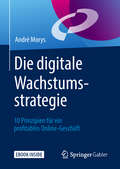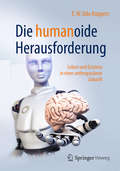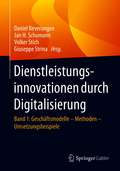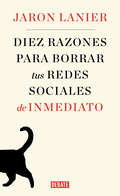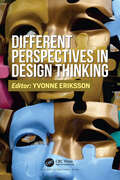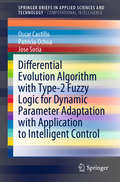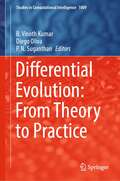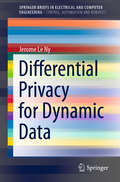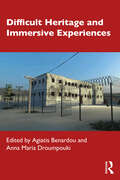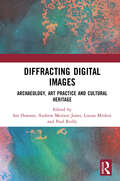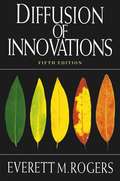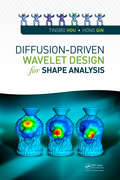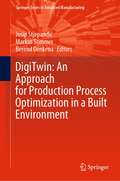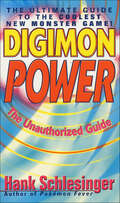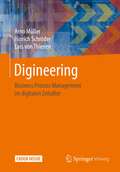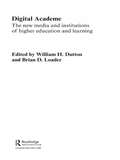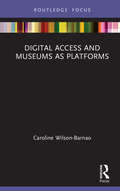- Table View
- List View
Die digitale Wachstumsstrategie: 10 Prinzipien für ein profitables Online-Geschäft
by André Morys Patrick CastronovoAndré Morys liefert mit diesem Buch die Essenz aus seiner 20-jährigen Strategie- und Conversion-Beratung – im Mittelstand sowie in Dax-Konzernen. Er stellt die zehn wirklich entscheidenden Erfolgsfaktoren für nachhaltiges Wachstum im Online-Business vor und liefert konkrete Bausteine, Optimierungshebel und Implementierungs-Schritte für deren erfolgreiche Umsetzung im unternehmerischen Alltag. Im Vorwort schreibt er: „In diesem Buch erkläre ich nicht, ob der Warenkorb-Button oben oder unten stehen muss. Das wäre nicht nützlich. Ich erkläre stattdessen ein grundlegendes System, das Unternehmen implementieren müssen, um dauerhaft ihren Umsatz verbessern zu können.“ Dieses Buch ist für Optimierer geschrieben, die ihre Aktivitäten auf ein neues Level bringen wollen, und für Geschäftsführer, CMOs und E-Commerce-Manager, die den entscheidenden Kern hinter dem Ziel „Wachstum durch digitale Transformation“ verstehen wollen. Aus dem InhaltParadoxien: blinde Flecken und Brüche auf dem Weg zu Wandel und WachstumDie qualitative Arbeit: die Realität sehen, um Dinge zu verändern Die quantitative Arbeit: die Spreu vom Weizen trennen Die 10 Erfolgsfaktoren: die Strategie als Fundament für das Wachstum Priorisierung: vorwärts kommen, ohne den Überblick zu verlieren Optimieren: so vermeiden Sie die gröbsten FehlerDie Umsetzung: Bausteine, Optimierungshebel, Implementierungs-SchritteDer AutorAndré Morys zählt zu den einflussreichsten deutschsprachigen Experten im Bereich Online-Marketing und E-Commerce. Er ist Dozent an der Fachhochschule Würzburg, Blogger (konversionsKRAFT), Autor und Vorstand der Web Arts AG. 2016 wurde er im Rahmen der SMX zur Online-Marketing-Persönlichkeit des Jahres gewählt.„… der Zugang zu Tools entscheidet selten über Erfolg oder Misserfolg. Das Erfolgsrezept heißt Menschen + Prozesse + Tools. Mit der systematischen Präzision, die wir von den Deutschen gewohnt sind, erschließt André mit seinem Buch genau dieses Erfolgsrezept. Deshalb bin ich so begeistert von André's Buch.“ Avinash Kaushik, Digital Marketing Evangelist
Die elektronische Welt mit Arduino entdecken (O'Reillys Basics)
by Erik BartmannDie Arduino-Plattform hat die Do-It-Yourself-Bewegung revolutioniert. Der kleine, leistungsfähige Mikrocontroller mit seiner leicht zu bedienenden Entwicklungsumgebung ist aus der Elektronikwelt nicht mehr wegzudenken. In zahllosen Projekten, in denen elektronisch gesteuert und gemessen wird, findet man mittlerweile den Arduino-Mikrocontroller. Arduino kann jeder Der Arduino ist leicht zu programmieren, und elektronische Zusatzteile wie LCDs, Sensoren und Motoren können einfach integriert und angesteuert werden. Die ersten Schritte mit dem Mikrocontroller sind also leicht zu gehen. Um jedoch den Mikrocontroller für praktisch alle Steuerungsvorgänge zu nutzen, ist ein solides elektronisches Grundwissen hilfreich. Die Elektronik-Grundlagen verstehen Mit Die elektronische Welt mit Arduino entdecken lernst du den Arduino-Mikrocontroller Schritt für Schritt kennen und erfährst, wie er von deinem PC aus gesteuert wird. Gleichzeitig erhältst du eine fundierte Einführung in die faszinierende Welt der Elektronik. So lernst du quasi spielerisch die physikalischen Grundlagen der Elektronik. Projekte, Projekte, Projekte Nach den Grundlagen, die dir leicht verständlich und mit alltagsnahen Beispielen versehen nahe gebracht werden, warten 34 konkrete Arduino-Projekte auf dich: vom einfachen blinkenden LCD über den Bau eines Lichtradars bis hin eigenständig agierenden Roboterfahrzeug. Langlebiges Arduino-Nachschlagewerk in Farbe
Die humanoide Herausforderung: Leben und Existenz in einer anthropozänen Zukunft
by E.W. Udo KüppersCui bono? – Wem nutzt die Entwicklung humanoider Maschinen oder Automaten? Dieses Buch erörtert die Details dieses Spannungsfelds und die Herausforderung gesellschaftlicher Weiterentwicklung. Als technisch-elektronische Handhabungsgeräte können sie den Menschen zuträglich sein, sie von körperlich belastenden Arbeiten oder sogenannten Routinearbeiten befreien. Der Autor versucht die Fragen zu beleuchten: Was erwartet die Menschheit durch die Entwicklung einer künstlichen Intelligenz in einer menschähnlichen Maschine? Was aber, wenn der selbstbestimmende Mensch an der Schwelle steht, sich selbst durch intelligente selbstorganisierte Produkte und Prozesse eine humanoide Konkurrenz zu schaffen, die er möglicherweise nicht mehr kontrollieren kann?
Die zehn Usability-Gebote: Wie man Webseiten Besser macht
by Eric ReissWebsites, die intuitiv bedienbar sind, haben zufriedenere Nutzer und zufriedene Nutzer kommen wieder. Das ist das eigentliche Ziel der Usability und Eric Reiss zeigt Ihnen in diesem Buch, mit welchen einfachen Maßnahmen Sie es erreichen. Er gibt Ihnen zehn Grundprinzipien oder "Gebote" an die Hand - so sollte Ihre Website beispielsweise bequem, funktional und idiotensicher sein. Was Sie dafür tun oder besser bleiben lassen sollten, zeigt er Ihnen an zahllosen Beispielen aus dem Web. Aber auch Bratpfannen, Straßenschilder oder Badematten müssen schon einmal herhalten, um zu erklären, wie wir Dinge verwenden und was uns fluchen lässt, wenn etwas nicht so funktioniert, wie wir es erwarten. Neben jeder Menge erstaunlicher Aha-Erlebnisse und amüsanter Anekdoten bietet Ihnen jedes Kapitel am Ende eine Liste mit zehn Fragen, mit denen Sie mögliche Fallstricke aufspüren und Ihre Website maximal benutzerfreundlich gestalten können. Und da Eric Reiss die zehn Usability-Gebote nicht nur aufgeschrieben, sondern beim Schreiben dieses Buchs auch selbst berücksichtigt hat, werden Sie sehen: Es funktioniert.
Die zweite Quantenrevolution: Vom Spuk Im Mikrokosmos Zu Neuen Supertechnologien
by Lars Jaeger„Quantenphysik ist bizarr und komisch, und sie widerspricht komplett unserem gesunden Menschenverstand“ oder ganz einfach „Die spinnen, die Physiker“ - so oder ähnlich ist die Wahrnehmung vieler Menschen, wenn es um die Grundtheorie der modernen Physik geht. Die These dieses Buches lautet: „Quantenphysik, so bizarr und abgehoben sie erscheinen mag, ist für unser heutiges Leben die bedeutendste wissenschaftliche Theorie. Und ihr Einfluss ist bei weitem nicht an irgendein Ende gelangt. Da kommt noch einiges auf uns zu!“ Der Autor steigt dabei mitten in unser Alltagsleben ein: Sie wollen mehr über heutige und zukünftige Technologien erfahren? Dann beschäftigen Sie sich mit dem Quantencomputer oder dem Quanteninternet; Technologien, deren erste Prototypen in den letzten Jahren möglich wurden und schon sehr bald unser tägliches Leben bestimmen werden. Das Buch wird Bewusstsein schaffen für die Bedeutung der Quantenphysik heute, dabei werden auch philosophische und weltanschauliche Fragen nicht außer Acht gelassen. Am Schluss wird der Leser den heutigen Stand der Quantenphysik kennen und dabei Antwort auf Fragen finden, die Einstein, Bohr, Heisenberg und andere Physik-Genies des 20. Jahrhunderts noch nicht wussten. Mit diesem Buch erschließen sich ihm nicht nur eine Reihe ganz neuer Technologien, sondern auch die dramatischen Einflüsse der modernen Physik für das Gefüge unserer Weltanschauung.
Dienstleistungsinnovationen durch Digitalisierung: Band 1: Geschäftsmodelle – Methoden – Umsetzungsbeispiele
by Volker Stich Daniel Beverungen Jan H. Schumann Giuseppe StrinaDieses Buch stellt neue Geschäftsmodelle und Methoden vor, mit denen Dienstleistungsinnovationen durch den Einsatz digitaler Technologien erfolgreich umgesetzt werden.Schwerpunkte des ersten Bandes sind neuartige Methoden zur Entwicklung und Einführung von Dienstleistungsinnovationen, die Gestaltung dienstleistungsorientierter Geschäftsmodelle in industriellen Anwendungsszenarien sowie die Planung und Umsetzung modularer und mobiler Softwarelösungen für digitale Dienstleistungssysteme.Zahlreiche Umsetzungsbeispiele zeigen konkret und praxisnah auf, wie Unternehmen digitale Geschäftsmodelle selbst entwickeln, neue Methoden sicher anwenden und Dienstleistungsinnovationen erfolgreich realisieren.
Dienstleistungsinnovationen durch Digitalisierung: Band 2: Prozesse – Transformation – Wertschöpfungsnetzwerke
by Volker Stich Daniel Beverungen Jan Hendrik Schumann Giuseppe StrinaDieses Buch stellt neue Geschäftsmodelle und Methoden vor, mit denen Dienstleistungsinnovationen durch den Einsatz digitaler Technologien erfolgreich umgesetzt werden.Ein Schwerpunkt des zweiten Bandes sind neue Methoden für die digitale Transformation von Dienstleistungsprozessen in der Industrie, Logistik und Gesundheitsbranche. Das Buch stellt dabei auch besondere Herausforderungen und Lösungen für die digitale Transformation kleiner und mittlerer Unternehmen (KMU) vor und zeigt, wie dort neue Geschäftsmodelle umgesetzt werden. Die Entwicklung und Nutzung digitaler Plattformen stellt abschließend eine spezifische Perspektive auf neue Kooperationsformen in Wertschöpfungsnetzwerken dar. Zahlreiche Umsetzungsbeispiele zeigen konkret und praxisnah auf, wie Unternehmen digitale Geschäftsmodelle selbst entwickeln, neue Methoden sicher anwenden und Dienstleistungsinnovationen erfolgreich realisieren können.
Diez razones para borrar tus redes sociales de inmediato
by Jaron LanierUn brillante manifiesto que llama a la acción para comenzar a reinventar Internet. ¿Te cuesta imaginar una vida sin redes sociales? ¿Y si te dieran 10 argumentos explicando la toxicidad de sus efectos? En este libro, Jaron Lanier nos explica con una contundencia abrumadora como las redes sociales, al desplegar una vigilancia constante y manipular el inconsciente de sus usuarios, nos están convirtiendo en personas rencorosas, tristes, asustadizas, poco empáticas, aisladas y triviales. Si quieres una vida más feliz, un mundo más justo y pacífico, o simplemente la oportunidad de pensar por ti mismo sin ser monitoreado e influenciado por las corporaciones más ricas de la historia, lo mejor que puedes hacer es cancelar tus cuentas. Ahora. Reseñas:«Jaron Lanier es un genio.»Sunday Times «Mezcla sabiduría profética con una simple practicidad. Lectura esencial.»The New York Times «El título lo dice todo... Lanier aboga por desanclarse de las redes sociales, que fomentan la adicción y la anomia y en general nos hacen sentir peor y más temerosos el uno del otro y del mundo. El experimento podría ser útil, aunque oscurecerá los corazones de los señores oscuros, un argumento ganador por sí mismo.»Kirkus Reviews
Different Perspectives in Design Thinking
by Yvonne ErikssonGlobalization and digitalization are buzz words in contemporary society. They affect both our private and our professional lives. Society has become more diverse with easier access to information and to virtual platforms that gives us opportunity to be in touch with colleagues, friends, family, etc. at any time. A complex environment is emerging wherein internet of things and big data are being integrated with products, production systems, healthcare, and daily activity and play an important part in decision making. This has an impact on future designs and the role of designers. Responsible designers with a holistic perspective are needed.The book highlights several aspects of design thinking such as Information Design and Critical Design. The meaning of culture, gender and disabilities are also discussed. The functions of Information Design are changing from ‘showing the way’, instruction manuals and graphic design. It will affect among others, healthcare technology, smart products and Industry 4.0. Design thinking perspective that includes users from the entire chain and from the producer to the end user of the product or service, is needed. This will also require gender and culture issues to be taken into consideration in designing products and services. Design thinking methods and critical aspects of design will contribute to an inclusive society.
Differential Evolution Algorithm with Type-2 Fuzzy Logic for Dynamic Parameter Adaptation with Application to Intelligent Control (SpringerBriefs in Applied Sciences and Technology)
by Oscar Castillo Patricia Ochoa Jose SoriaThis book focuses on the fields of fuzzy logic, bio-inspired algorithm, especially the differential evolution algorithm and also considering the fuzzy control area. The main idea is that these two areas together can help solve various control problems and to find better results. In this book, the authors test the proposed method using five benchmark control problems. First, the water tank, temperature, mobile robot, and inverted pendulum controllers are considered. For these 4 problems, experimentation was carried out using a Type-1 fuzzy system and an Interval Type-2 system. The last control problem was the D.C. motor, for which the experiments were performed with Type-1, Interval Type-2, and Generalized Type-2 fuzzy systems. When we use fuzzy systems combined with the differential evolution algorithm, we can notice that the results obtained in each of the controllers are better and with increasing uncertainty, the results are even better. For this reason, the authors consider in this book the proposed method using fuzzy systems and the differential evolution algorithm to improve the fuzzy controllers’ behavior in complex control problems.
Differential Evolution: From Theory to Practice (Studies in Computational Intelligence #1009)
by Diego Oliva B. Vinoth Kumar P. N. SuganthanThis book addresses and disseminates state-of-the-art research and development of differential evolution (DE) and its recent advances, such as the development of adaptive, self-adaptive and hybrid techniques. Differential evolution is a population-based meta-heuristic technique for global optimization capable of handling non-differentiable, non-linear and multi-modal objective functions. Many advances have been made recently in differential evolution, from theory to applications. This book comprises contributions which include theoretical developments in DE, performance comparisons of DE, hybrid DE approaches, parallel and distributed DE for multi-objective optimization, software implementations, and real-world applications. The book is useful for researchers, practitioners, and students in disciplines such as optimization, heuristics, operations research and natural computing.
Differential Privacy for Dynamic Data (SpringerBriefs in Electrical and Computer Engineering)
by Jerome Le NyThis Springer brief provides the necessary foundations to understand differential privacy and describes practical algorithms enforcing this concept for the publication of real-time statistics based on sensitive data. Several scenarios of interest are considered, depending on the kind of estimator to be implemented and the potential availability of prior public information about the data, which can be used greatly to improve the estimators' performance. The brief encourages the proper use of large datasets based on private data obtained from individuals in the world of the Internet of Things and participatory sensing. For the benefit of the reader, several examples are discussed to illustrate the concepts and evaluate the performance of the algorithms described. These examples relate to traffic estimation, sensing in smart buildings, and syndromic surveillance to detect epidemic outbreaks.
Difficult Heritage and Immersive Experiences
by Agiatis Benardou and Anna Maria DroumpoukiDifficult Heritage and Immersive Experiences examines the benefits involved in designing and employing immersive technologies to reconstruct difficult pasts at heritage sites around the world. Presenting interdisciplinary case studies of heritage sites and museums from across a range of different contexts, the volume analyzes the ways in which various types of immersive technologies can help visitors to contextualize and negotiate difficult or sensitive heritage and traumatic pasts. Demonstrating that some of the most creative applications of immersive experiences appear in and at museums and heritage sites, the book showcases how immersive technologies offer the possibility of confronting and disputing presumptions and prejudices, triggering responses, delivering new knowledge, initiating dialogue and challenging preexistingnotions of collective identity. The book provides a conceptual, as well as a hands-on, approach to understanding the use of immersive technologies at sensitive sites around the globe. Difficult Heritage and Immersive Experiences is essential reading for researchers and students who are interested in, or engaged in the study of, cultural heritage, memory, history, politics, dark tourism, design and digital media or immersive technologies. The book will also be of interest to museum and heritage practitioners.
Diffracting Digital Images: Archaeology, Art Practice and Cultural Heritage
by Ian Dawson Andrew Meirion Jones Paul Reilly Louisa MinkinDigital imaging techniques have been rapidly adopted within archaeology and cultural heritage practice for the accurate documentation of cultural artefacts. But what is a digital image, and how does it relate to digital photography? The authors of this book take a critical look at the practice and techniques of digital imaging from the stance of digital archaeologists, cultural heritage practitioners and digital artists. Borrowing from the feminist scholar Karen Barad, the authors ask what happens when we diffract the formal techniques of archaeological digital imaging through a different set of disciplinary concerns and practices. Diffracting exposes the differences between archaeologists, heritage practitioners and artists, and foregrounds how their differing practices and approaches enrich and inform each other. How might the digital imaging techniques used by archaeologists be adopted by digital artists, and what are the potentials associated with this adoption? Under the gaze of fine artists, what happens to the fidelity of the digital images made by archaeologists, and what new questions do we ask of the digital image? How can the critical approaches and practices of fine artists inform the future practice of digital imaging in archaeology and cultural heritage? Diffracting Digital Images will be of interest to students and scholars in archaeology, cultural heritage studies, anthropology, fine art, digital humanities, and media theory.
Diffusion Under Confinement: A Journey Through Counterintuition
by Leonardo Dagdug Jason Peña Ivan Pompa-GarcíaThis book offers the reader a journey through the counterintuitive nature of Brownian motion under confinement. Diffusion is a universal phenomenon that controls a wide range of physical, chemical, and biological processes. The transport of spatially-constrained molecules and small particles is ubiquitous in nature and technology and plays an essential role in different processes. Understanding the physics of diffusion under conditions of confinement is essential for a number of biological phenomena and potential technological applications in micro- and nanofluidics, among others. Studies on diffusion under confinement are typically difficult to understand for young scientists and students because of the extensive background on diffusion processes, physics, and mathematics that is required. All of this information is provided in this book, which is essentially self-contained as a result of the authors’ efforts to make it accessible to an audience of students from a variety of different backgrounds. The book also provides the necessary mathematical details so students can follow the technical process required to solve each problem. Readers will also find detailed explanations of the main results based on the last 30 years of research devoted to studying diffusion under confinement. The authors approach the physical problem from various angles and discuss the role of geometries and boundary conditions in diffusion. This textbook serves as a comprehensive and modern overview of Brownian motion under confinement and is intended for young scientists, graduate students, and advanced undergraduates in physics, physical chemistry, biology, chemistry, chemical engineering, biochemistry, bioengineering, and polymer and material sciences.
Diffusion of Innovations, 5th Edition
by Everett M. RogersNow in its fifth edition, Diffusion of Innovations is a classic work on the spread of new ideas.In this renowned book, Everett M. Rogers, professor and chair of the Department of Communication & Journalism at the University of New Mexico, explains how new ideas spread via communication channels over time. Such innovations are initially perceived as uncertain and even risky. To overcome this uncertainty, most people seek out others like themselves who have already adopted the new idea. Thus the diffusion process consists of a few individuals who first adopt an innovation, then spread the word among their circle of acquaintances--a process which typically takes months or years. But there are exceptions: use of the Internet in the 1990s, for example, may have spread more rapidly than any other innovation in the history of humankind. Furthermore, the Internet is changing the very nature of diffusion by decreasing the importance of physical distance between people. The fifth edition addresses the spread of the Internet, and how it has transformed the way human beings communicate and adopt new ideas.
Diffusion-Driven Wavelet Design for Shape Analysis
by Hong Qin Tingbo HouFrom Design Methods and Generation Schemes to State-of-the-Art ApplicationsWavelets are powerful tools for functional analysis and geometry processing, enabling researchers to determine the structure of data and analyze 3D shapes. Suitable for researchers in computer graphics, computer vision, visualization, medical imaging, and geometric modeling
DigiTools: Technology Application Tools
by Jack P. Hoggatt Jon A. Shank Karl BarksdaleDIGITOOLS is a one-semester course that reflects a new direction being taken in keyboarding. It not only includes the standard teaching methods for learning to type and format documents, but also covers computer applications such as word processing, presentations, speech recognition, database and spreadsheet, and the Internet.
DigiTwin: An Approach for Production Process Optimization in a Built Environment (Springer Series in Advanced Manufacturing)
by Berend Denkena Josip Stjepandić Markus SommerThe focus of this book is an application of Digital Twin as a concept and an approach, based on the most accurate view on a physical production system and its digital representation of complex engineering products and systems. It describes a methodology to create and use Digital Twin in a built environment for the improvement and optimization of factory processes such as factory planning, investment planning, bottleneck analysis, and in-house material transport. The book provides a practical response based on achievements of engineering informatics in solving challenges related to the optimization of factory layout and corresponding processes. This book introduces the topic, providing a foundation of knowledge on process planning, before discussing the acquisition of objects in a factory and the methods for object recognition. It presents process simulation techniques, explores challenges in process planning, and concludes by looking at future areas of progression. By providing a holistic, trans-disciplinary perspective, this book will showcase Digital Twin technology as state-of-the-art both in research and practice.
Digimon Power: The Ultimate Guide to the Coolest New Monster Game!
by Hank SchlesingerThe hottest new craze in monster games is DigiMon--short for Digital Monsters. Players must hatch, raise, and train their DigiMons in order to battle with other DigiMon--and that's where the fun begins. The ultimate guide to this awesome game, DIGIMON POWER, in detailed, kid-friendly language, gives readers:*All the fun facts about the DigiMon phenomenon, including the video game, trading cards, action figures, and the DigiMon TV show. *In-depth monster facts, plus the coolest hints, tips, tricks, and secrets from kids just like you*An exciting look at Japanese cartoon-anime, and television shows we might see in the future*Hot info about other monster games, trading cards, and shows, like Tamagotchi, Pokemon, and Monster Rancher*And much, much more!
Digineering: Business Process Management im digitalen Zeitalter
by Arno Müller Hinrich Schröder Lars von ThienenAls Folge der zunehmenden Verfügbarkeit neuer Informationstechnologien entstehen völlig neue Kundenerwartungen, Geschäftsmodelle und Prozesse. Die umfassende Neugestaltung digitaler Prozesse ist mit Konzepten der Vergangenheit nicht zu bewältigen. Business Process Management benötigt angepasste Methoden, Fähigkeiten, Technologien und Strukturen.„Digineering“ steht für die Kombination der Aspekte einer zunehmenden Digitalisierung mit den Methoden und Vorgehensweisen des Re-Engineering und überträgt damit Ansätze aus dem Business Process Management, dem Management der digitalen Transformation und dem Software-Engineering auf die aktuellen Herausforderungen der Prozessdigitalisierung. „Digineering“ liefert einen agilen Lösungsansatz, der alle Phasen der Prozessdigitalisierung von der Analyse der Kundenanforderungen über die Prozessgestaltung bis zur Implementierung neuer IT-Anwendungen umfasst. In allen Phasen werden die Potenziale innovativer IT einbezogen, um so ganzheitliche Prozesse mit einzigartigem Kundenerlebnis und hoher Effizienz zu schaffen.
Diginomics Research Perspectives: The Role of Digitalization in Business and Society (Advanced Studies in Diginomics and Digitalization)
by Lars HornufThis book focuses on traditional fields of business studies and economics and how digitalization has affected them. It provides an overview about the lessons learned from academic research and highlights implications for practitioners. Digitalization has not only changed the ways business administration and economics are taught, but also the substance at the core of the two disciplines. Chapters from expert contributors define and carefully evaluate the developments that have occurred over the last decades. The authors further provide an assessment of how industry branches have adapted and in which form regulators have engaged. Attention is given to the theoretical and empirical findings from recent scholarly literature. Furthermore, the authors provide some novel insights from their own research at the University of Bremen. This book appeals to business administration, economics, and entrepreneurship scholars and practitioners alike.
Digital @ Scale: The Playbook You Need to Transform Your Company
by Anand Swaminathan Jürgen MeffertA blueprint for reinventing the core of your business Value in the next phase of the digital era will go to those companies that don't just try digital but also scale it. Digital@Scale examines what it takes for companies to break through the gravitational pull of their legacy organizations and capture the full value of digital. Digging into more than fifty detailed case studies and years of McKinsey experience and data, the authors, along with a group of expert contributors, show how companies can move beyond incremental change to transform the business where the greatest value is generated—at its core. The authors provide practical insights into the three pillars of digital transformations that successfully scale: reinventing the business model, building out a business architecture from the customer back into the organization, and establishing an 'amoeba' IT and organizational foundation that learns and evolves. This is the ideal guide for all leaders who recognize the power and promise of a digital transformation.
Digital Academe: New Media in Higher Education and Learning
by Brian D. Loader William H. DuttonThis book responds to an ever-increasing call from educators, policy makers, journalists, parents and the public at large for analysis that cuts through the hype surrounding the information revolution to address key issues associated with new media in higher education and learning. This collection is of value to those who are seeking a critical, non-commercial exposition of both the enormous opportunities and challenges for higher education that are tied to the use of new information and communication technologies (ICTs) in the development of distance education and distributed learning.The chapters are written by leading exponents, practitioners and researchers from a variety of disciplinary perspectives and the collection as a whole spans national boundaries and reaches beyond the research community to relate to issues of policy and practice.
Digital Access and Museums as Platforms (Museums in Focus)
by Caroline Wilson-BarnaoDigital Access and Museums as Platforms draws on interviews with museum practitioners, along with a range of case studies from public and private institutions, in order to investigate the tensions and benefits involved in making cultural collections available using digital technologies. Taking a media and critical studies approach to the museum and raising questions about the role of privately owned search engines in facilitating museum experiences, the book questions who collects what, for whom objects are collected and what purpose these objects and collections serve. Connecting fieldwork undertaken in Australia and New Zealand with the global practices of technology companies, Wilson-Barnao brings attention to an emerging new model of digital ownership and moderation. Considering the synergising of these institutions with media systems, which are now playing a more prominent role in facilitating access to culture, the book also explores the motivations of different cultural workers for constructing the museum as a mediatised location. Digital Access and Museums as Platforms will be of interest to academics and students working in the fields of museum studies, art, culture, media studies and digital humanities. Weighing in on conversations about how technologies are being incorporated into museums, the book should also be useful to practitioners working in museums and galleries around the world.
